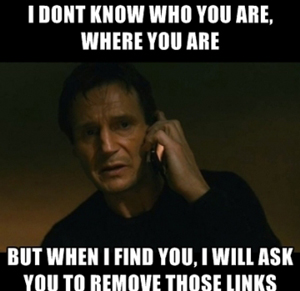
Negative SEO can be a lot of things—and it’s more than just black hat tricks. In fact, you might be the victim of negative SEO attacks and not even know it if someone has launched a campaign against you and your site. The good news is that it’s very risky to undertake a negative SEO campaign, so most people won’t take that gamble. However, if you are a target, then that means whoever’s behind it has some serious beef with you. Negative SEO encompasses just about anything that’s “illegal” in terms of SEO best practices. Since Google is the largest search engine, it’s often used as the basis for what’s “good” SEO and what’s not allowed. For example, using duplicate content (such as buying multiple similar domains, then copying and pasting the information) is a huge SEO no-go and, while this is technically considered to be negative SEO, it often happens as an oversight and not intentional.
There are some negative SEO strategies that are purely down and dirty. Here are some of the most common strategies and how to know if you’re a victim.
1. Pointing bad links your way.
One of the best and most organic ways to improve your search engine ranking is by developing a good quantity of quality inbound and outbound links. You have total control over the links present on your website, but what about other people who link to your site? Most of the time it’s a huge compliment when someone links to your site, because it means they feel it is worth linking their name with your reputation. However, someone who has negative SEO on the brain can pay for poor links or find them by hand and then point them in your direction. You may not even realize you’re being connected to sites that will drag down your SEO. These sites might be spam sites or simply unrelated to your content. Either way, your SEO will suffer.
How to avoid:
Use the WebCEO Backlink Checker Tool in order to see a full and a clean picture of the sites linking to you. With the WebCEO backlink quality reports you will keep control of:
- The percentage of toxic links out of all links to your site or the percentage of nofollow links from linking domains.
- The status of pages linking to you.
- The diversity of linking texts.
- Toxicity of incoming links.
2. False accusations
Google and other search engines have stringent policies in place to ensure that any reports made against you are carefully vetted. However, a false complaint that appears legitimate to Google might linger longer than desirable, or it might require substantial effort to address. If someone is upset with you, it’s relatively easy for them to report you to Google, alleging black hat SEO tactics. Of course, this is also easy for a search engine to cross-check. Surprisingly, it happens more frequently than one might expect, even though it’s straightforward for a search engine to identify potentially false reports.
This kind of situation can occur like a “crime of passion,” where the person targeting you may be unaware of the consequences they might face, or they might not care. In these scenarios, being proactive about your website’s SEO health is crucial. Regularly using tools like WebCEO’s Website Audit can help ensure your site adheres to white hat SEO practices and is compliant with search engine guidelines. This way, if you are falsely reported, you have a solid foundation to dispute any claims.
Moreover, maintaining an up-to-date audit report can serve as evidence of your compliance and good practices, which can be invaluable in disputing any wrongful accusations. It’s also a good idea to regularly check your backlink profile using tools like WebCEO’s Backlink Checker to ensure that your site is not associated with any dubious or harmful websites, which can be a common area of concern in false reports.
Being wrongly accused of black hat SEO practices can be distressing, but with the right tools and a proactive approach to website management, you can swiftly address these issues and maintain your site’s integrity.
3. Review bombs
Review bombing actually sounds like a good thing at first blush. It’s when someone saturates the most popular review sites with glowing reviews about your business—sweet, right? However, that’s a huge red flag that makes it look like you’re either doing it yourself or paying people to do it. Either way, that’s not an appropriate SEO best practice. However, it can be tough to figure out who’s behind it. Alternatively, someone might pepper sites with negative reviews that are false. This is reverse review bombing and it can be even more dangerous. Some review sites make it nearly impossible to remove reviews unless they’re abusive, so your only tactic is to bury them under genuine and organic reviews. This can be a laborious process and it’s often too much for a website to manage.
How to avoid:
Go to the WebCEO Web Buzz Monitoring tool and use it as your Reputation Management tool. Enter your branded terms together with product names and keep tracking mentions of your site, product or company on various review platforms. If you see negative reviews, join conversations in order to redeem yourself.
If you suspect negative SEO, work with the search engine of your choice. If you know who’s behind it and it’s safe, try approaching them (either with legal help or not). Sometimes misunderstandings can be blown way out of proportion.




